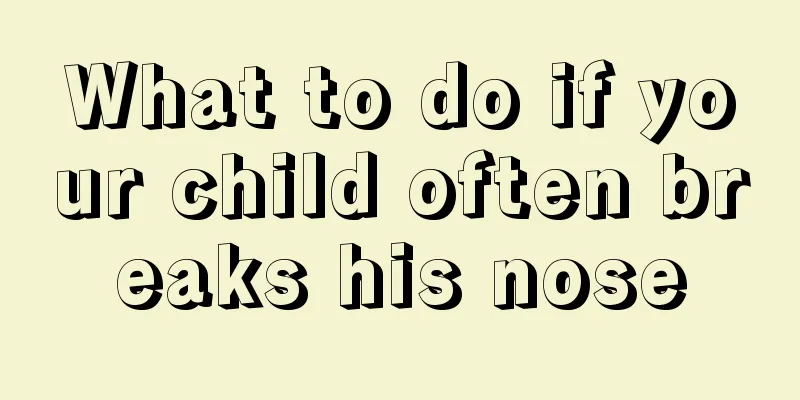What to do if your child often breaks his nose

|
A child's broken nose, or nosebleed, is most likely to occur when the child is injured or hit in the nose. When a child has a nosebleed, as long as the bleeding is stopped in time, it will not cause major impact on the body. The cause of nosebleeds is very clear. As long as you pay more attention, it will not occur frequently. If nosebleeds occur frequently, you should learn more about the possible causes. So, what should you do if your child often breaks his nose? The causes of nose bleeding in children are generally as follows: Nosebleeds may be caused by dry air, which makes the nasal mucosa dry, fragile, and prone to bleeding. You can go to the hospital to get some paraffin oil or peppermint oil to apply to your nasal cavity, or you can ask a doctor to check and burn the blood vessels in your nasal cavity to avoid frequent bleeding. A blood test should also be done to check for any blood system diseases. See the ENT doctor to see if there is a deviated nasal septum, etc. You should drink more water, eat more vegetables and avoid pinching your nose. Epistaxis in children often occurs in the front and lower part of the nasal septum. There is a vascular network composed of arteries and veins in the front and lower part of the nasal septum. The mucosa here is thin and the veins have no valves. It is medically called the nasal bleeding area. Because of its forward location, it is easy to bleed when impacted by external force. There are many reasons for nosebleeds, both local and systemic. Local causes include nasal trauma, vestibulitis, nasal foreign bodies, nasal hemangioma, etc.; systemic causes include upper respiratory tract inflammation, aplastic anemia, thrombocytopenic purpura, cirrhosis, vitamin C deficiency, hemophilia, leukemia, etc. When a child has a nosebleed, parents should not panic. The child should be placed in a sitting or semi-sitting position, with the head slightly tilted forward. The child should not be placed in a supine position, nor should the head be tilted back, to prevent blood from choking the respiratory tract. If blood flows into the pharynx, irritating the pharynx and coughing will aggravate the bleeding. At this time, you can apply a cold towel to your head and apply slight pressure on the wings of your nose with your fingers for 3 to 5 minutes. You can also use sterilized cotton dipped in 0.1% epinephrine solution or Yunnan Baiyao to fill the nasal cavity for 10 minutes, and then gently remove the cotton. Finger pressure hemostasis If there is a small amount of bleeding in the front of the nasal septum or occasional bleeding with a small amount, finger pressure can be used to stop the bleeding. Use your thumb and index finger to pinch the nostrils on both sides and apply pressure for 5-10 minutes. During the pressure period, you can also apply a cold towel, cold water bag or ice bag to the patient's forehead and back of the neck to promote vasoconstriction and reduce nose bleeding. Nasal packing hemostasis When the patient has a heavy nosebleed, nasal packing can be used to stop the bleeding while preparing to go to the hospital. Gently pack the patient's anterior and posterior nares with tightly rolled gauze or cotton strips, and pinch the two nostrils tightly with the index finger and thumb to apply pressure to stop the bleeding. When inserting the gauze or cotton strip, be careful to leave a little bit of it exposed outside to facilitate removal. |
<<: The child has a stuffy nose and snores
>>: The dangers of spanking children
Recommend
What are the symptoms of chlamydia infection in children
Children will always have many common diseases in...
15-month-old baby early education
A 15-month-old baby is already over one year old....
Why does my 3-year-old baby have leg pain?
The baby’s health is the focus of every family’s ...
Can a two-month-old baby be held upright?
A two-month-old baby is still in the neonatal per...
What to do if your two and a half year old baby coughs
Symptoms of coughing often appear in babies under...
Does umbilical hernia affect the baby? Moms, please watch carefully!
Many people do not understand the various disease...
Precautions for acute laryngitis in children
We all know that if children are sick when they a...
Normal temperature range for three-year-old children
In fact, when children are sick, the most common ...
Symptoms of malnutrition in children, it turns out we have ignored them!
In the eyes of many people, only children who loo...
What to do if your child has a fever
Every child’s growth from childhood to adulthood ...
How to prevent baby’s enteritis after taking medicine?
Spring is here. If you don't pay attention to...
What causes yellow teeth in children?
Because children's cognition in many aspects ...
How to do infant health exercises
After the child is born, we as parents should hel...
How to treat childhood asthma?
Asthma troubles many people, mostly middle-aged a...
Basic symptoms of yellow tongue in newborns
In fact, some of the organs of newborns are not y...









